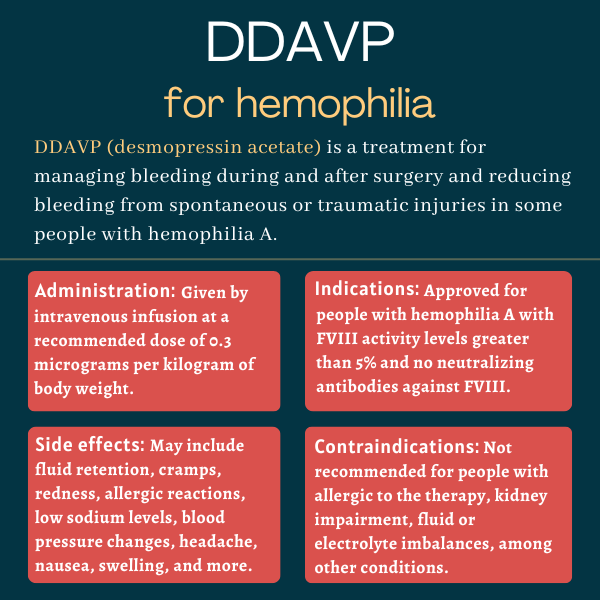DDAVP (desmopressin acetate) for hemophilia
Last updated Sept. 18, 2025, by Marisa Wexler, MS

What is DDAVP for hemophilia?
DDAVP (desmopressin acetate) is a therapy approved to help control bleeding during and after surgery, as well as to reduce bleeding with episodes of spontaneous or traumatic injuries in certain people with hemophilia A.
DDAVP contains desmopressin, an artificial form of a hormone naturally produced in the body that works by increasing the levels of certain clotting factors, including factor VIII (FVIII) — the clotting protein that is missing or is faulty in people with hemophilia A.
In the U.S., DDAVP is currently available in an injectable formulation. Only the injectable formulation is approved to treat hemophilia A. When used for this indication, DDAVP is administered via an intravenous, or into-the-vein, infusion.
Besides hemophilia A, the injectable formulation of DDAVP is also approved to maintain bleed control during and after surgery or traumatic injuries and to reduce bleeding with episodes of spontaneous or traumatic injuries in people with another bleeding disorder called von Willebrand disease (VWD) type 1. It may also be used to help manage a form of diabetes called central diabetes insipidus.
Ferring Pharmaceuticals manufactures the brand-name therapy, but generic formulations are also available.
An intranasal spray formulation of desmopressin acetate that can be used to stop some types of bleeds in people with mild hemophilia A and mild to moderate VWD type 1 is also available. Manufactured by STAQ Pharma, this form of desmopressin acetate is identical to that found in Stimate, a brand-name therapy manufactured by Ferring that was approved to manage some types of bleeds in people with hemophilia A and VWD type 1 before being discontinued in the U.S. after a market recall.
Therapy snapshot
| Brand name: | DDAVP Injection |
| Chemical name: | Desmopressin acetate |
| Usage: | Used to control bleeding during and after surgery and reduce bleeding with episodes of spontaneous or traumatic injuries in hemophilia A patients |
| Administration: | Intravenous infusion |
Who with hemophilia can take DDAVP?
DDAVP is approved in the U.S. for use in people with hemophilia A whose FVIII activity levels are higher than 5% of what is considered normal and who do not have neutralizing antibodies against FVIII. The therapy is specifically indicated for controlling bleeding during and after surgery and reducing bleeding with episodes of spontaneous or traumatic injuries.
DDAVP is contraindicated, or not recommended, to be used by anyone:
- with a known allergy to the therapy or any of its components
- with moderate-to-severe kidney impairment (creatinine clearance below 50 mL/min)
- who has low blood sodium levels (hyponatremia) or a history of hyponatremia
- with known or suspected syndrome of inappropriate antidiuretic hormone (SIADH) secretion, a condition marked by excessive fluid retention and hyponatremia
- who has excessive thirst (polydipsia)
- who is taking certain medications, namely loop diuretics or systemic or inhaled glucocorticoids
- with an illness that can cause fluid or electrolyte imbalances
- with heart failure or uncontrolled high blood pressure.
DDAVP’s prescribing information also includes a boxed warning noting the therapy can cause hyponatremia, which can be life-threatening in severe cases.
Due to the risk of hyponatremia and fluid retention, patients taking DDAVP are advised to limit fluid intake to a minimum from one hour before dosing to eight hours after.
How is DDAVP administered in hemophilia?
DDAVP is administered by an infusion into the bloodstream. The infusion is done under the guidance of a healthcare professional and may take 15 to 20 minutes to complete. The recommended dosage is 0.3 micrograms per kilogram of body weight, up to a maximum of 20 micrograms.
If used before surgery to control bleeding associated with the procedure, DDAVP should be administered about half an hour before the surgery starts. If used to reduce spontaneous or traumatic bleeding, DDAVP may be re-administered after about eight to 12 hours, and once daily thereafter, if needed.
The effects of DDAVP may be less potent when the therapy is given repeatedly in a short timeframe (e.g., when given more frequently than every 48 hours). It may be necessary to wait two or three days before the full effects of DDAVP are reproducible.

DDAVP in hemophilia clinical trials
DDAVP was first tested in people with hemophilia A in a 1977 study conducted in Italy. Results showed that:
- when DDAVP was administered before dental surgery and re-administered shortly thereafter, two out of four people with hemophilia A had no bleeding following dental extraction; the other two had some oozing and required treatment with plasma concentrates
- DDAVP helped manage bleeding during dental extractions and major surgery in six people with mild hemophilia A and two with VWD.
Following the 1977 study, a series of other studies demonstrated that DDAVP could be used to help control bleeding during surgery and manage bleeding episodes in people with hemophilia A or VWD.
Common side effects of DDAVP
Common side effects of DDAVP include:
- abdominal cramps and burning pain
- redness and facial flushing
- fluid retention and swelling
- headache
- allergic reactions
- low blood sodium levels, which can lead to seizures
- abnormally high or low blood pressure
- nausea
- tachycardia (abnormally fast heartbeat)
- blood clot events.
DDAVP can cause hyponatremia, which can be life-threatening if not identified and treated promptly. DDAVP should not be used in people who are at an increased risk of developing severe hyponatremia, such as those with illnesses that can cause fluid or electrolyte imbalances and those taking loop diuretics or systemic or inhaled glucocorticoids. Blood sodium levels should be checked before patients start receiving DDAVP and monitored regularly if the therapy is given long-term. If hyponatremia occurs, treatment with DDAVP should be paused or discontinued.
Other notable safety considerations associated with the use of DDAVP include:
- alterations in blood pressure; blood pressure monitoring is recommended during DDAVP treatment, particularly in patients with a history of heart disease or hypertension
- severe allergic reactions; patients should be closely monitored for potential allergic reactions, and treatment should be interrupted if such a reaction occurs
- fluid retention, which can worsen other underlying conditions; DDAVP is not recommended for individuals with increased intracranial pressure or a history of urinary retention.
Hemophilia News Today is strictly a news and information website about the disease. It does not provide medical advice, diagnosis or treatment. This content is not intended to be a substitute for professional medical advice, diagnosis, or treatment. Always seek the advice of your physician or other qualified health provider with any questions you may have regarding a medical condition. Never disregard professional medical advice or delay in seeking it because of something you have read on this website.
Recent Posts
- For women with hemophilia, speaking up is an act of courage
- Early Hemlibra use prevents bleeding in babies with hem A
- After the dark days of hemophilia, I’m thankful for peace at home
- Women with hemophilia may feel different, but shouldn’t be ashamed
- Preclinical data bring human trial launch closer for MGX-001






